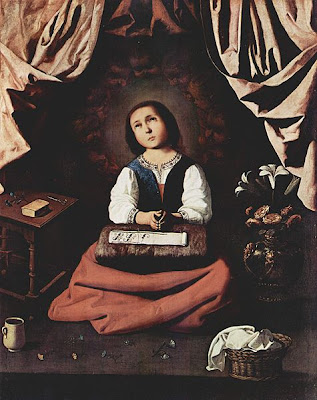
Here is the conclusion to the Rosary Novena according to the Rose Paths as set forth in The Rosarian Handbook:
“PART THREE: LAST THREE DAYSSource:
“[1] Opening Prayer [Same as the first three days]
“[2] On the Last three days of the Novena the Glorious Mysteries are recited. The Glorious Mysteries follow the PATHS OF YELLOW ROSES in Mary’s Rose Garden.
“FIRST MYSTERY: Christ arises on the third day. Ask for Mary’s lively faith.
“SECOND MYSTERY: Christ ascends into Heaven. Ask for Mary’s firm hope.
“THIRD MYSTERY: The Holy Ghost descends upon the Apostles. Ask for Mary’s zeal for the glory of God.
“FOURTH MYSTERY: Mary’s Body is taken to Heaven. Ask for Mary’s union with the Heart of Jesus.
“FIFTH MYSTERY: Mary is crowned Queen of the Angels and of Saints. Ask for final perseverance.
“PRAYER AFTER THE BEADS:
“Give me, O Queen of the Most Holy Rosary, the courage and confidence that comes through THE RESURRECTION. Help me always to look forward to the great hope of our Holy Religion, given in THE ASCENSION. Teach me to live in the Spirit of the first Novena which thou and the Apostles made in preparation for the COMING OF THE HOLY GHOST. Inspire me with the GLORY OF THINE ASSUMPTION and the joy that was thine when at THE CORONATION thou wert made QUEEN OF HEAVEN AND EARTH.
“O Blessed Mother, with thy Rosary in my hand, I PLACE MY PETITIONS in thy care.
"[Here pause and mention your intentions.]
“O Queen of the Most Holy Rosary, I am mindful of thy great goodness to ST. DOMINIC, THE FIRST PREACHER OF THE ROSARY, I HONOR THEE for the aid given to ST. PIUS when the Cross triumphed over the Turkish Crescent. LOVINGLY DO I RECALL the eighteen Rosary apparitions to ST. BERNADETTE AT LOURDES, where thou wert pleased to instruct this poor peasant girl in the power of thine own devotion. I ACKNOWLEDGE THEE, O Queen of the Most Holy Rosary, as the Mother of my Lord and my God. Thy Son is my First Beginning and Last End. I RENDER UNTO HIM the homage of my being, and I SUBMIT MYSELF to His divine service, now and for the remaining days of my life. Amen.
“[3] Invocations [Same as the first three days]
“[4] Prayer for the Apostolate of the Rosary [Same as the first three days]
“[5] The Litany of Loreto
"[6] Prayer to St. Joseph”
Dolan, Dominic, O.P. (Ed.); The Rosarian’s Handbook of the Society of the Rosary Altar (Marchbanks Press, New York, 1942), pp. 69-71.
All material from The Rosarian's Handbook used with the kind permission of the Dominican Province of St. Joseph.
Image:
A yellow rose, from Wikimedia Commons. Some rights reserved.














